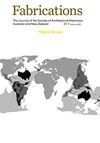Capturing a Cabinet of Curiosities: 3D Scanning a Building Heritage Collection
IF 0.3
0 ARCHITECTURE
Fabrications-The Journal of the Society of Architectural Historians Australia and New Zealand
Pub Date : 2021-09-02
DOI:10.1080/10331867.2021.1979778
引用次数: 0
Abstract
The use of 3D technologies in architectural research has long centred on capturing building sites and structures, however at the University of Melbourne a unique collection of heritage building materials has been the focus of an ambitious 3D scanning project. Conceived by Naomi Mullumby in collaboration with the Australian Centre for Architectural History, Urban and Cultural Heritage, the project team consisted of University staff and professionals with architectural backgrounds. Ben Waters and Belinda Yang of S-I projects undertook the 3d scans and Meher Bahl from Restore Conservation Services created the metadata, videos and forthcoming website. The objects in the Heritage Building Materials collection were accumulated by Professor Miles Lewis during his professional career and donated by him to the Architecture, Building and Planning (ABP) Faculty (Fig. 1). The collection consists of over 300 objects ranging from small nails to large iron roofing sheets, categorised under five broad headings: bricks, cement & plaster, ironmongery, decorative finishes and roofing. These objects were collected by Lewis or were gifted to him by his colleagues and students. The physical objects have been used to complement teaching of built heritage within the Faculty where they enable students to gain an understanding of the evolution of construction materials and their use in Australia, and of global influences on Australian architectural methods. The physical objects are held in glass cabinets within the Faculty, with limited curation, visibility and accessibility (Fig. 2). Their digitisation as 3D objects, with highly descriptive metadata and accompanying video interviews with Lewis, has been significant in opening up a specialised and largely unknown collection to a potentially global audience of researchers who can now visually interrogate the objects and understand their historical and environmental context.捕捉一柜奇物:建筑遗产的3D扫描
3D技术在建筑研究中的应用长期以来一直集中在捕捉建筑遗址和结构上,然而在墨尔本大学,一个独特的遗产建筑材料收藏一直是一个雄心勃勃的3D扫描项目的重点。该项目团队由Naomi Mullumby与澳大利亚建筑历史、城市和文化遗产中心合作构思,由大学工作人员和具有建筑背景的专业人员组成。S-I项目的Ben Waters和Belinda Yang进行了三维扫描,恢复保护服务的Meher Bahl创建了元数据、视频和即将推出的网站。遗产建筑材料收藏中的物品是Miles Lewis教授在其职业生涯中积累的,并由他捐赠给建筑、建筑和规划学院(ABP)(图1)。该系列包括300多件物品,从小钉子到大铁皮屋面板,分为五大类:砖、水泥和灰泥、五金、装饰饰面和屋顶。这些物品是刘易斯收集的,或者是他的同事和学生送给他的。实物被用于补充学院内的建筑遗产教学,使学生了解建筑材料的演变及其在澳大利亚的使用,以及全球对澳大利亚建筑方法的影响。实物存放在学院内的玻璃柜中,管理、可见性和可及性有限(图2)。它们作为3D物体的数字化,以及高度描述性的元数据和对Lewis的视频采访,对于向潜在的全球研究人员开放一个专门的、基本上不为人知的收藏具有重要意义,这些研究人员现在可以直观地询问这些物体,并了解它们的历史和环境背景。
本文章由计算机程序翻译,如有差异,请以英文原文为准。
求助全文
约1分钟内获得全文
求助全文
来源期刊

CiteScore
0.50
自引率
25.00%
发文量
26
 求助内容:
求助内容: 应助结果提醒方式:
应助结果提醒方式:


